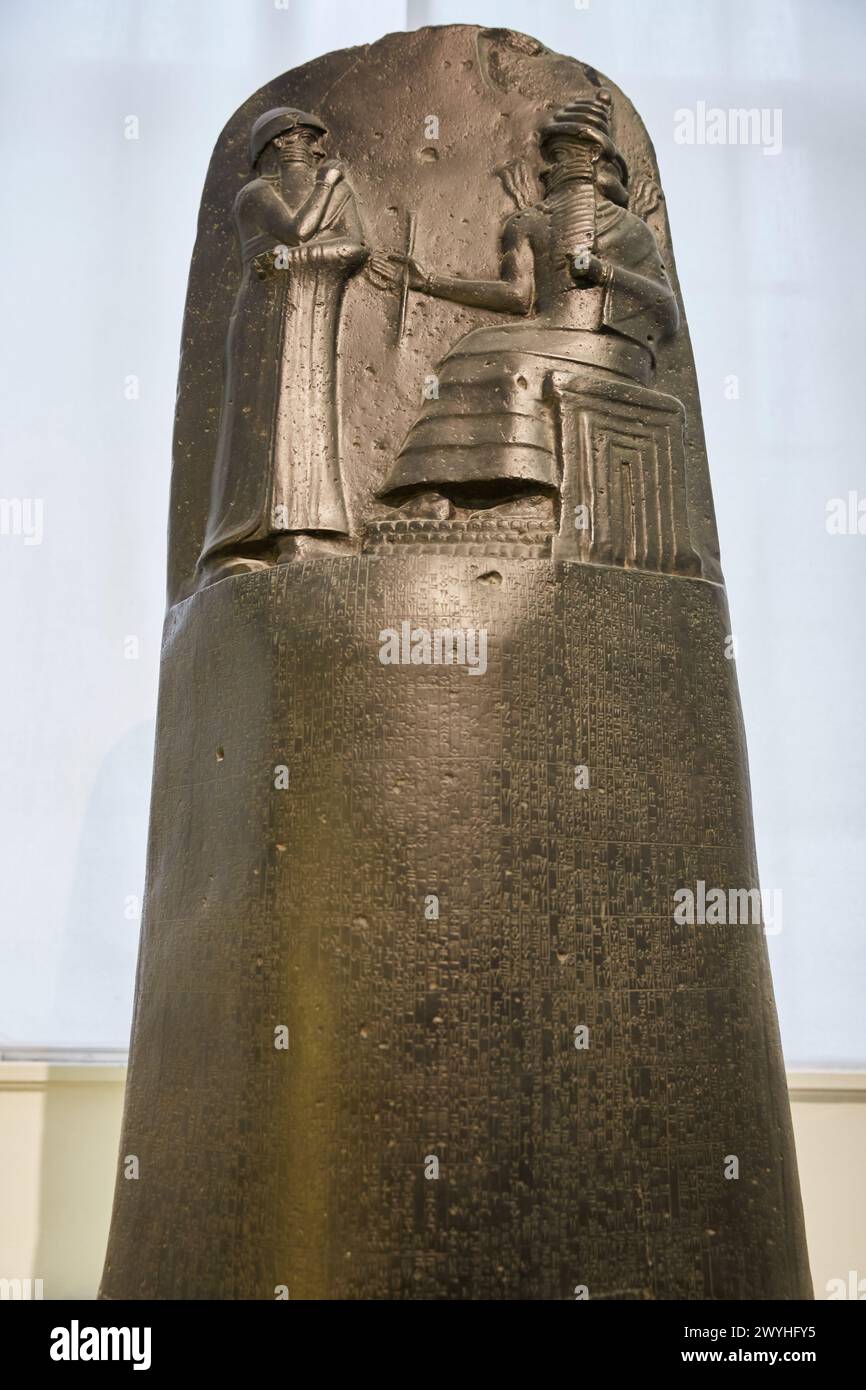Quick filters:
Hammurabi stela Stock Photos and Images
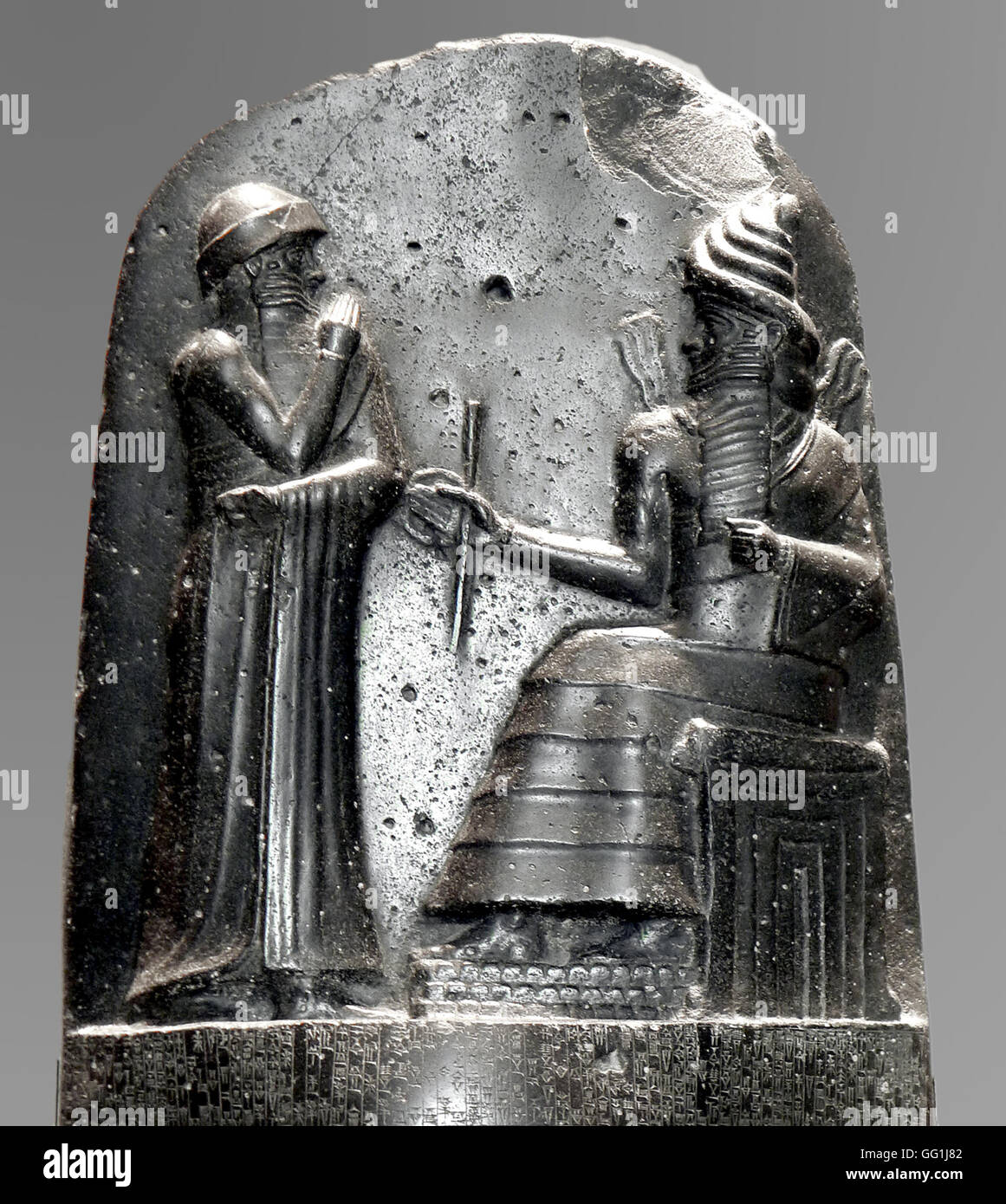 2860. CODE OF HAMMURABI - BABYLON, SUSA (IRAN), 1750 B.C. ON THE TOP OF THE BLACK DIORITE STELA IS DEPICTED THE KING STANDING Stock Photohttps://www.alamy.com/image-license-details/?v=1https://www.alamy.com/stock-photo-2860-code-of-hammurabi-babylon-susa-iran-1750-bc-on-the-top-of-the-113132994.html
2860. CODE OF HAMMURABI - BABYLON, SUSA (IRAN), 1750 B.C. ON THE TOP OF THE BLACK DIORITE STELA IS DEPICTED THE KING STANDING Stock Photohttps://www.alamy.com/image-license-details/?v=1https://www.alamy.com/stock-photo-2860-code-of-hammurabi-babylon-susa-iran-1750-bc-on-the-top-of-the-113132994.htmlRMGG1J82–2860. CODE OF HAMMURABI - BABYLON, SUSA (IRAN), 1750 B.C. ON THE TOP OF THE BLACK DIORITE STELA IS DEPICTED THE KING STANDING
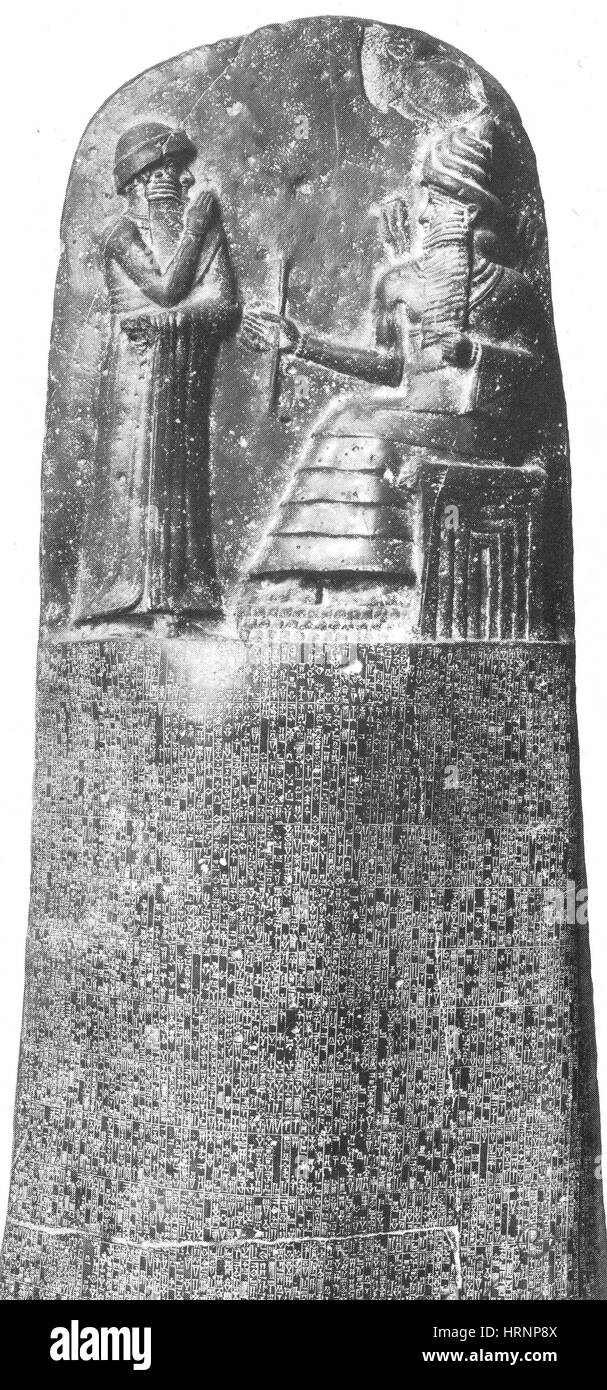 Code of Hammurabi, 1750 BC Stock Photohttps://www.alamy.com/image-license-details/?v=1https://www.alamy.com/stock-photo-code-of-hammurabi-1750-bc-135088154.html
Code of Hammurabi, 1750 BC Stock Photohttps://www.alamy.com/image-license-details/?v=1https://www.alamy.com/stock-photo-code-of-hammurabi-1750-bc-135088154.htmlRMHRNP8X–Code of Hammurabi, 1750 BC
 Fragments of stela(e) inscribed with cuneiform script: extracts from the code of King Hammurabi of Babylon (1792-1750 BC). Around 1750BC. Basalt. Stock Photohttps://www.alamy.com/image-license-details/?v=1https://www.alamy.com/fragments-of-stelae-inscribed-with-cuneiform-script-extracts-from-the-code-of-king-hammurabi-of-babylon-1792-1750-bc-around-1750bc-basalt-image327387310.html
Fragments of stela(e) inscribed with cuneiform script: extracts from the code of King Hammurabi of Babylon (1792-1750 BC). Around 1750BC. Basalt. Stock Photohttps://www.alamy.com/image-license-details/?v=1https://www.alamy.com/fragments-of-stelae-inscribed-with-cuneiform-script-extracts-from-the-code-of-king-hammurabi-of-babylon-1792-1750-bc-around-1750bc-basalt-image327387310.htmlRF2A0HNRX–Fragments of stela(e) inscribed with cuneiform script: extracts from the code of King Hammurabi of Babylon (1792-1750 BC). Around 1750BC. Basalt.
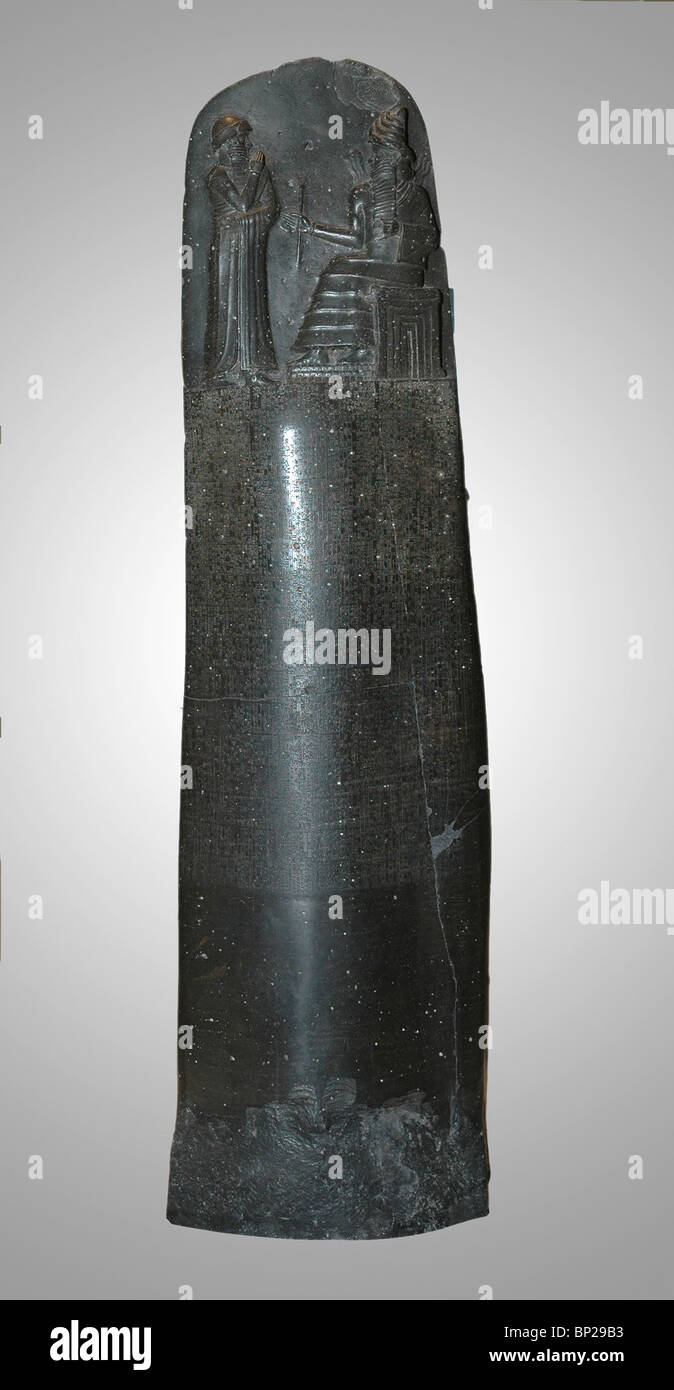 CODE OF HAMMURABI - BABYLON SUSA (IRAN) 1750 B.C. ON THE TOP OF THE BLACK DIORITE STELA IS DEPICTED THE KING STANDING IN FRONT Stock Photohttps://www.alamy.com/image-license-details/?v=1https://www.alamy.com/stock-photo-code-of-hammurabi-babylon-susa-iran-1750-bc-on-the-top-of-the-black-30784071.html
CODE OF HAMMURABI - BABYLON SUSA (IRAN) 1750 B.C. ON THE TOP OF THE BLACK DIORITE STELA IS DEPICTED THE KING STANDING IN FRONT Stock Photohttps://www.alamy.com/image-license-details/?v=1https://www.alamy.com/stock-photo-code-of-hammurabi-babylon-susa-iran-1750-bc-on-the-top-of-the-black-30784071.htmlRMBP29B3–CODE OF HAMMURABI - BABYLON SUSA (IRAN) 1750 B.C. ON THE TOP OF THE BLACK DIORITE STELA IS DEPICTED THE KING STANDING IN FRONT
 Votive offering. Fragment of a stone stele dedicated by Itur-Ashdum. First Dynasty of Babylon, c. 1760-1750 BC. Probably from Sippar, southern Iraq. Limestone. The cuneiform inscription states that a high official called Itur-Ashdum dedicated a statue to the goddess Ashratum in her temple, on behalf of King Hammurabi (reigned 1792-1750 BC). The figure carved may represent Hammurabi. British Museum. London, England, United Kingdom. Stock Photohttps://www.alamy.com/image-license-details/?v=1https://www.alamy.com/votive-offering-fragment-of-a-stone-stele-dedicated-by-itur-ashdum-first-dynasty-of-babylon-c-1760-1750-bc-probably-from-sippar-southern-iraq-limestone-the-cuneiform-inscription-states-that-a-high-official-called-itur-ashdum-dedicated-a-statue-to-the-goddess-ashratum-in-her-temple-on-behalf-of-king-hammurabi-reigned-1792-1750-bc-the-figure-carved-may-represent-hammurabi-british-museum-london-england-united-kingdom-image395207032.html
Votive offering. Fragment of a stone stele dedicated by Itur-Ashdum. First Dynasty of Babylon, c. 1760-1750 BC. Probably from Sippar, southern Iraq. Limestone. The cuneiform inscription states that a high official called Itur-Ashdum dedicated a statue to the goddess Ashratum in her temple, on behalf of King Hammurabi (reigned 1792-1750 BC). The figure carved may represent Hammurabi. British Museum. London, England, United Kingdom. Stock Photohttps://www.alamy.com/image-license-details/?v=1https://www.alamy.com/votive-offering-fragment-of-a-stone-stele-dedicated-by-itur-ashdum-first-dynasty-of-babylon-c-1760-1750-bc-probably-from-sippar-southern-iraq-limestone-the-cuneiform-inscription-states-that-a-high-official-called-itur-ashdum-dedicated-a-statue-to-the-goddess-ashratum-in-her-temple-on-behalf-of-king-hammurabi-reigned-1792-1750-bc-the-figure-carved-may-represent-hammurabi-british-museum-london-england-united-kingdom-image395207032.htmlRM2DXY6GT–Votive offering. Fragment of a stone stele dedicated by Itur-Ashdum. First Dynasty of Babylon, c. 1760-1750 BC. Probably from Sippar, southern Iraq. Limestone. The cuneiform inscription states that a high official called Itur-Ashdum dedicated a statue to the goddess Ashratum in her temple, on behalf of King Hammurabi (reigned 1792-1750 BC). The figure carved may represent Hammurabi. British Museum. London, England, United Kingdom.
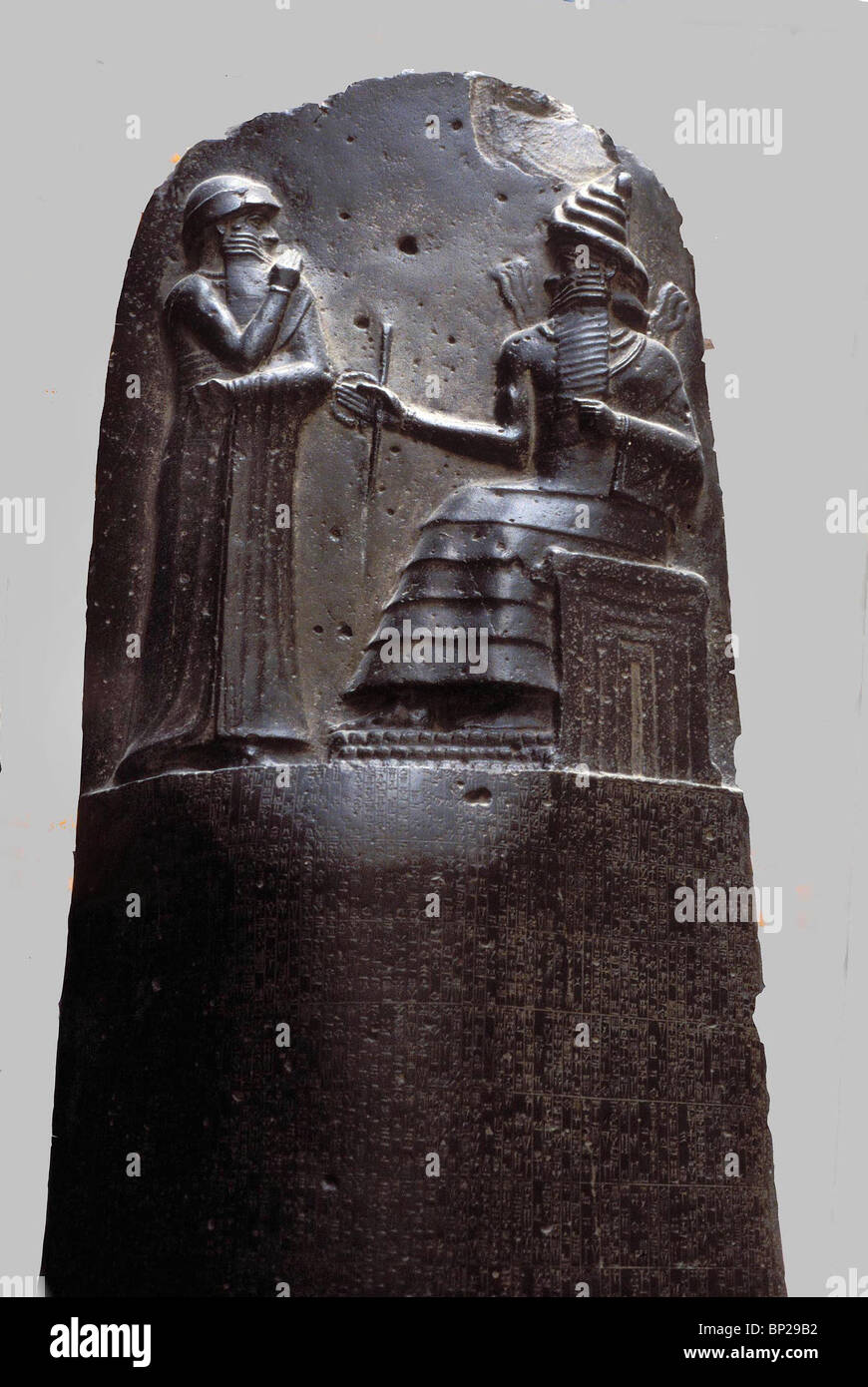 CODE OF HAMMURABI - BABYLON SUSA (IRAN) 1750 B.C. ON THE TOP OF THE BLACK DIORITE STELA IS DEPICTED THE KING STANDING IN FRONT Stock Photohttps://www.alamy.com/image-license-details/?v=1https://www.alamy.com/stock-photo-code-of-hammurabi-babylon-susa-iran-1750-bc-on-the-top-of-the-black-30784070.html
CODE OF HAMMURABI - BABYLON SUSA (IRAN) 1750 B.C. ON THE TOP OF THE BLACK DIORITE STELA IS DEPICTED THE KING STANDING IN FRONT Stock Photohttps://www.alamy.com/image-license-details/?v=1https://www.alamy.com/stock-photo-code-of-hammurabi-babylon-susa-iran-1750-bc-on-the-top-of-the-black-30784070.htmlRMBP29B2–CODE OF HAMMURABI - BABYLON SUSA (IRAN) 1750 B.C. ON THE TOP OF THE BLACK DIORITE STELA IS DEPICTED THE KING STANDING IN FRONT
 Tablet with bilingual inscription erected by King Hammurabi. Artist: Unknown Stock Photohttps://www.alamy.com/image-license-details/?v=1https://www.alamy.com/tablet-with-bilingual-inscription-erected-by-king-hammurabi-artist-unknown-image262771370.html
Tablet with bilingual inscription erected by King Hammurabi. Artist: Unknown Stock Photohttps://www.alamy.com/image-license-details/?v=1https://www.alamy.com/tablet-with-bilingual-inscription-erected-by-king-hammurabi-artist-unknown-image262771370.htmlRMW7E7FP–Tablet with bilingual inscription erected by King Hammurabi. Artist: Unknown
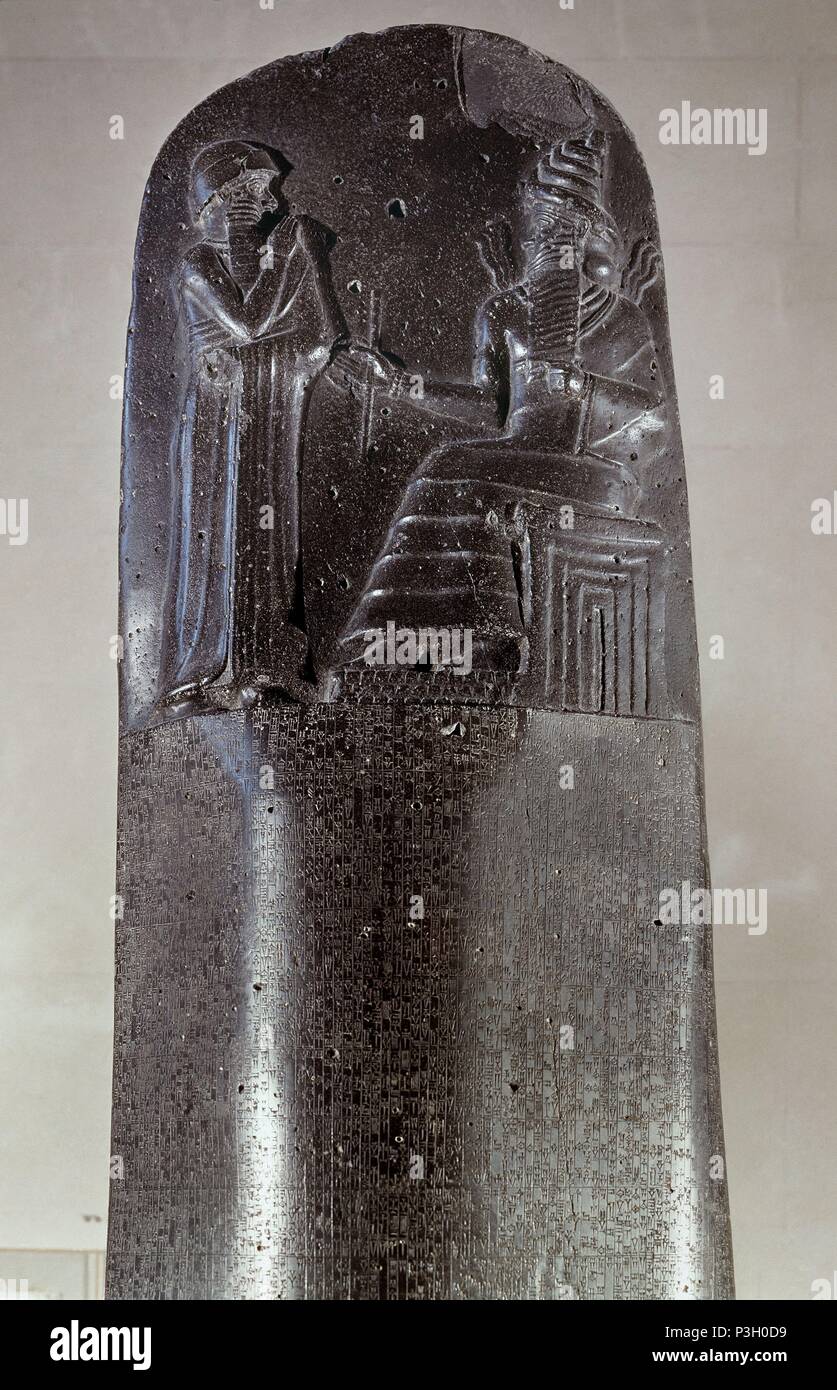 CODIGO DE HAMMURABI - PROCEDENTE DE SUSA - DIORITA - 1780 AC. Location: MUSEO DEL LOUVRE-ESCULTURAS, FRANCE. Stock Photohttps://www.alamy.com/image-license-details/?v=1https://www.alamy.com/codigo-de-hammurabi-procedente-de-susa-diorita-1780-ac-location-museo-del-louvre-esculturas-france-image208741941.html
CODIGO DE HAMMURABI - PROCEDENTE DE SUSA - DIORITA - 1780 AC. Location: MUSEO DEL LOUVRE-ESCULTURAS, FRANCE. Stock Photohttps://www.alamy.com/image-license-details/?v=1https://www.alamy.com/codigo-de-hammurabi-procedente-de-susa-diorita-1780-ac-location-museo-del-louvre-esculturas-france-image208741941.htmlRMP3H0D9–CODIGO DE HAMMURABI - PROCEDENTE DE SUSA - DIORITA - 1780 AC. Location: MUSEO DEL LOUVRE-ESCULTURAS, FRANCE.
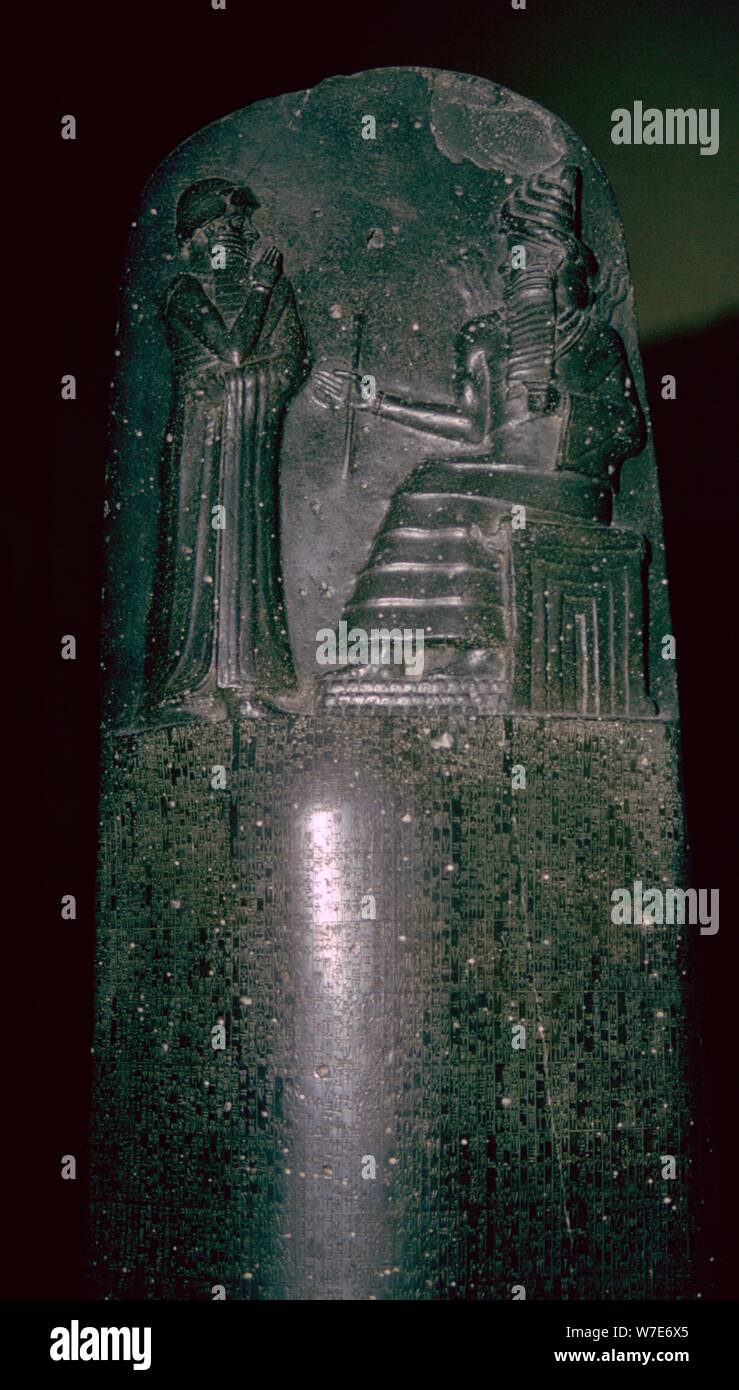 The Code of Hammurabi, 1792-1750 BC, 282 laws. Artist: Unknown Stock Photohttps://www.alamy.com/image-license-details/?v=1https://www.alamy.com/the-code-of-hammurabi-1792-1750-bc-282-laws-artist-unknown-image262770877.html
The Code of Hammurabi, 1792-1750 BC, 282 laws. Artist: Unknown Stock Photohttps://www.alamy.com/image-license-details/?v=1https://www.alamy.com/the-code-of-hammurabi-1792-1750-bc-282-laws-artist-unknown-image262770877.htmlRMW7E6X5–The Code of Hammurabi, 1792-1750 BC, 282 laws. Artist: Unknown
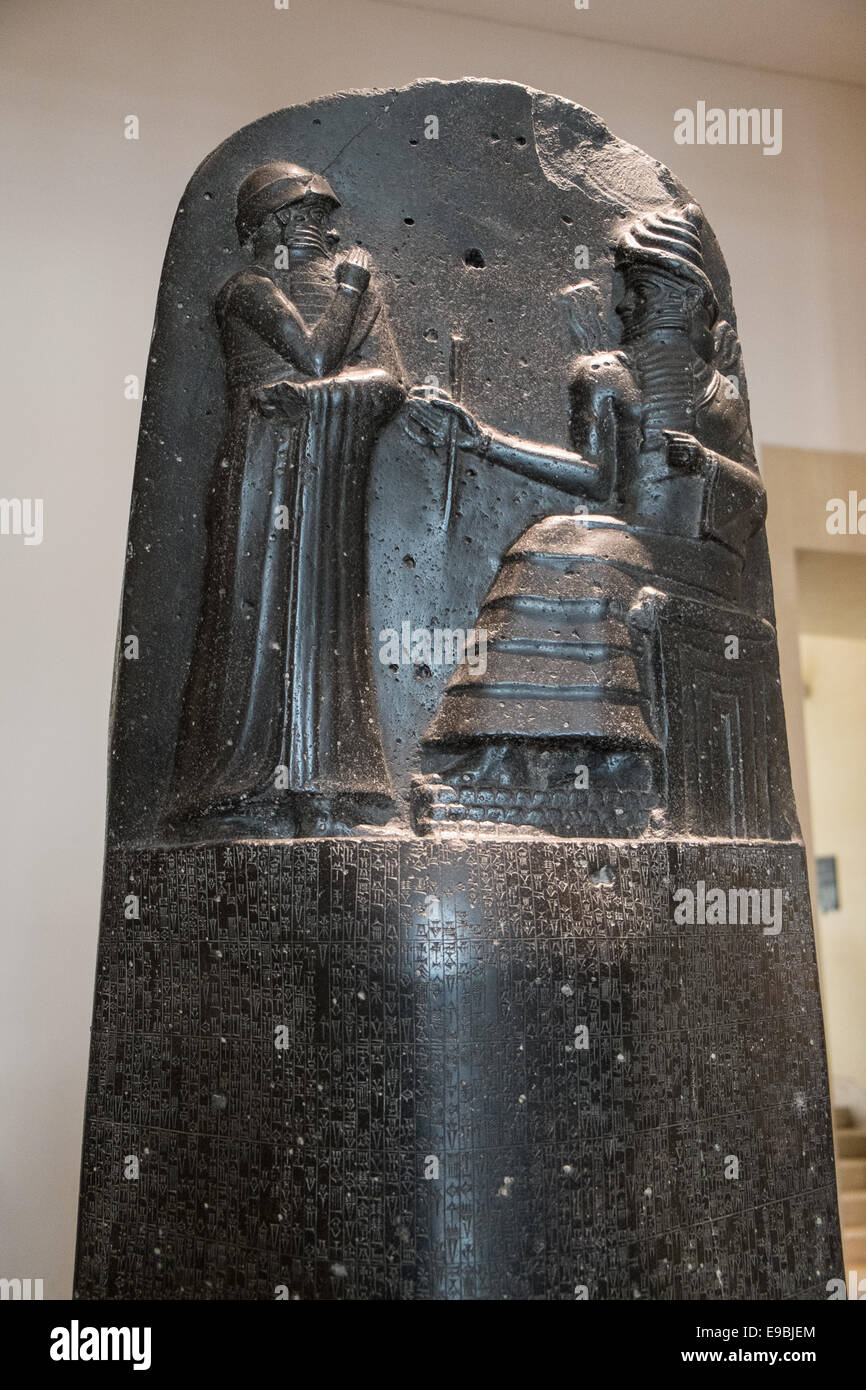 Law Code of Hammurabi, Mesopotamia,Louvre,Museum, Paris,France, Paris, France,Hammurabi,Hamurabi,Law,Code, Stock Photohttps://www.alamy.com/image-license-details/?v=1https://www.alamy.com/stock-photo-law-code-of-hammurabi-mesopotamialouvremuseum-parisfrance-paris-francehammurabihamurabilawcode-74629372.html
Law Code of Hammurabi, Mesopotamia,Louvre,Museum, Paris,France, Paris, France,Hammurabi,Hamurabi,Law,Code, Stock Photohttps://www.alamy.com/image-license-details/?v=1https://www.alamy.com/stock-photo-law-code-of-hammurabi-mesopotamialouvremuseum-parisfrance-paris-francehammurabihamurabilawcode-74629372.htmlRME9BJEM–Law Code of Hammurabi, Mesopotamia,Louvre,Museum, Paris,France, Paris, France,Hammurabi,Hamurabi,Law,Code,
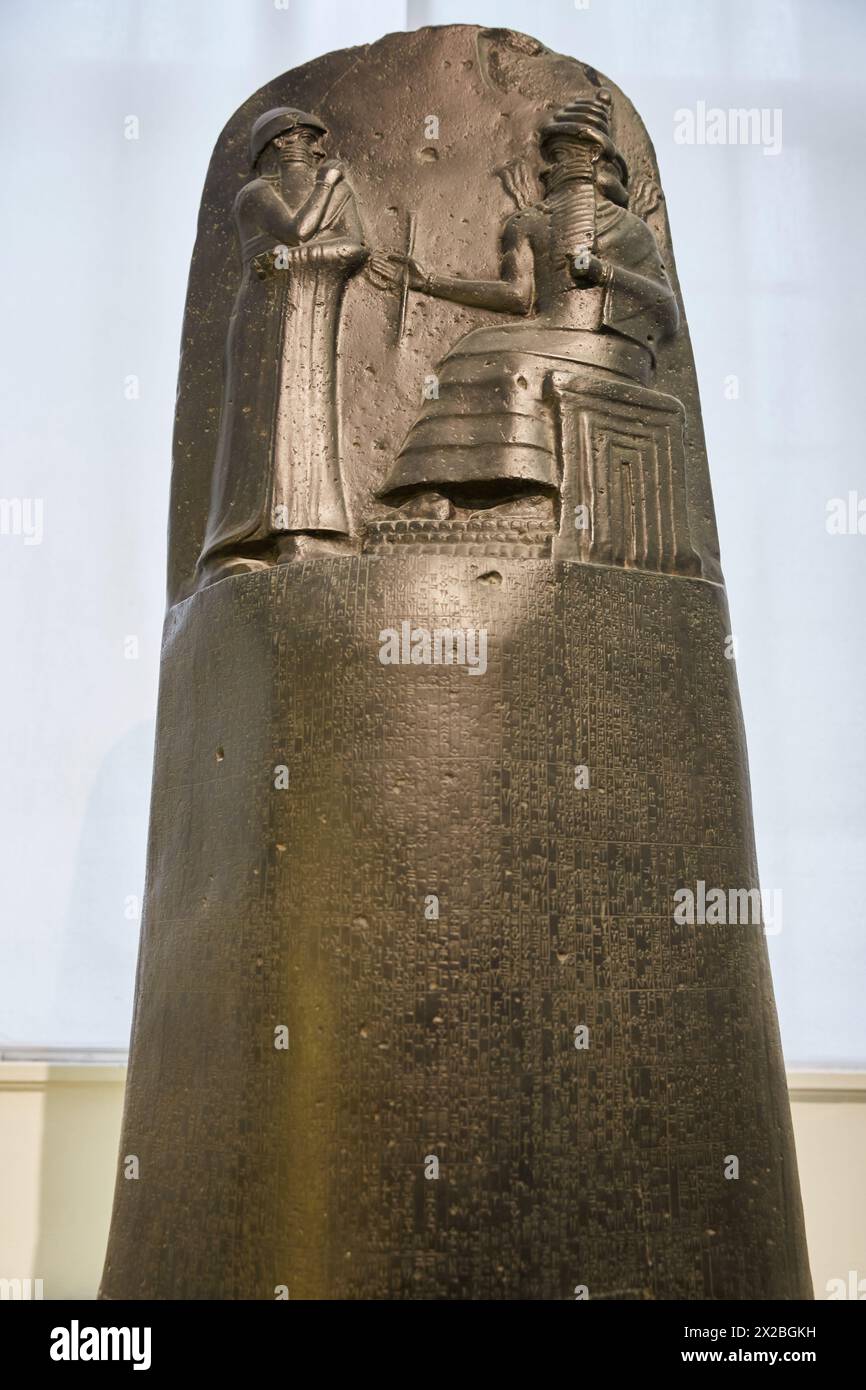 Code of Hammurabi, Babylon, Pergamon Museum, Berlin, Germany. Stock Photohttps://www.alamy.com/image-license-details/?v=1https://www.alamy.com/code-of-hammurabi-babylon-pergamon-museum-berlin-germany-image603846757.html
Code of Hammurabi, Babylon, Pergamon Museum, Berlin, Germany. Stock Photohttps://www.alamy.com/image-license-details/?v=1https://www.alamy.com/code-of-hammurabi-babylon-pergamon-museum-berlin-germany-image603846757.htmlRM2X2BGKH–Code of Hammurabi, Babylon, Pergamon Museum, Berlin, Germany.
 Tablet showing King Hammurapi at worship, First Dynasty of Babylon, about 1760-1750 BC. Artist: Unknown Stock Photohttps://www.alamy.com/image-license-details/?v=1https://www.alamy.com/tablet-showing-king-hammurapi-at-worship-first-dynasty-of-babylon-about-1760-1750-bc-artist-unknown-image262771770.html
Tablet showing King Hammurapi at worship, First Dynasty of Babylon, about 1760-1750 BC. Artist: Unknown Stock Photohttps://www.alamy.com/image-license-details/?v=1https://www.alamy.com/tablet-showing-king-hammurapi-at-worship-first-dynasty-of-babylon-about-1760-1750-bc-artist-unknown-image262771770.htmlRMW7E822–Tablet showing King Hammurapi at worship, First Dynasty of Babylon, about 1760-1750 BC. Artist: Unknown
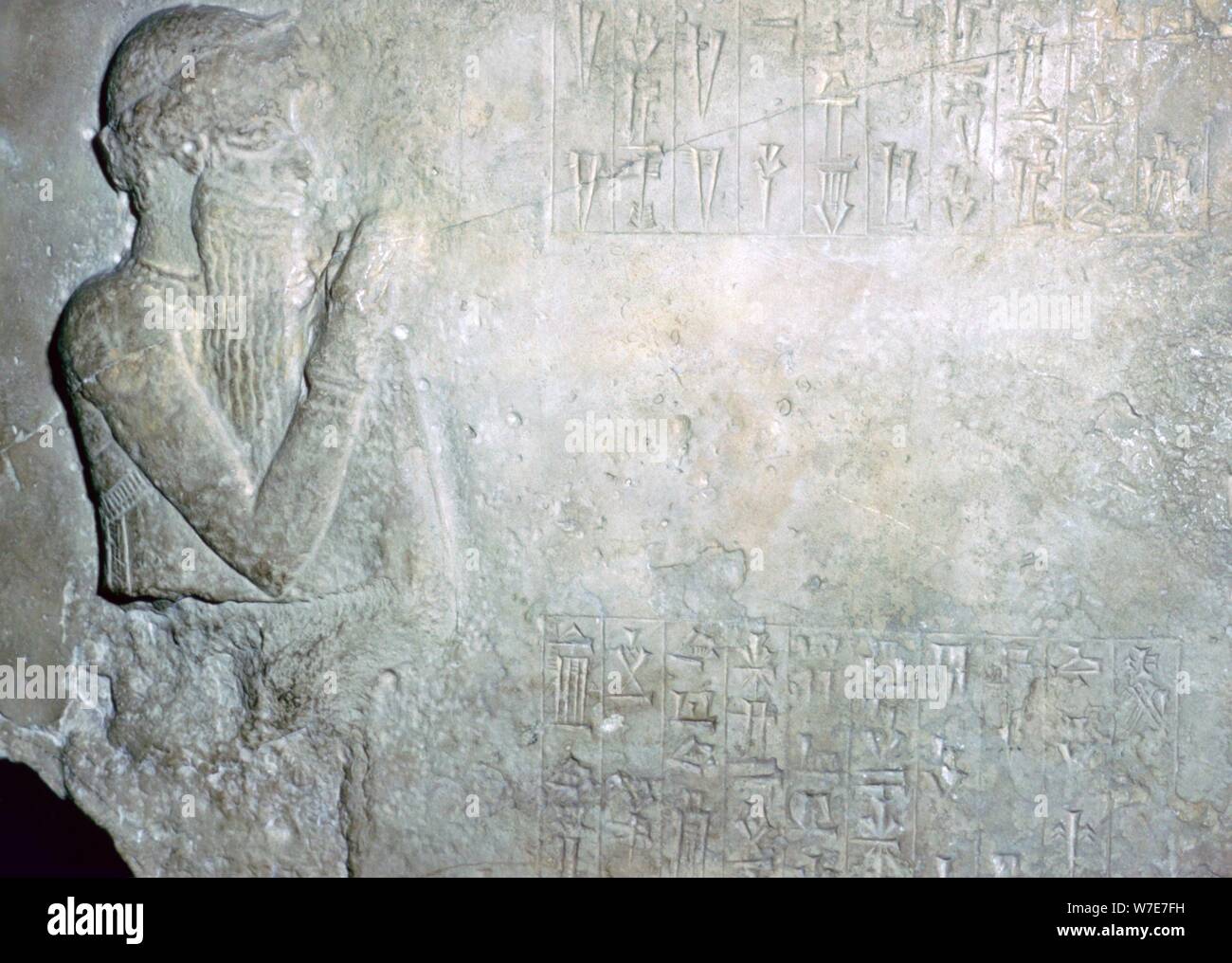 Tablet showing King Hammurapi at worship, First Dynasty of Babylon, about 1760-1750 BC. Artist: Unknown Stock Photohttps://www.alamy.com/image-license-details/?v=1https://www.alamy.com/tablet-showing-king-hammurapi-at-worship-first-dynasty-of-babylon-about-1760-1750-bc-artist-unknown-image262771365.html
Tablet showing King Hammurapi at worship, First Dynasty of Babylon, about 1760-1750 BC. Artist: Unknown Stock Photohttps://www.alamy.com/image-license-details/?v=1https://www.alamy.com/tablet-showing-king-hammurapi-at-worship-first-dynasty-of-babylon-about-1760-1750-bc-artist-unknown-image262771365.htmlRMW7E7FH–Tablet showing King Hammurapi at worship, First Dynasty of Babylon, about 1760-1750 BC. Artist: Unknown
 Hammurabi, Babylonian King Stock Photohttps://www.alamy.com/image-license-details/?v=1https://www.alamy.com/stock-photo-hammurabi-babylonian-king-135088155.html
Hammurabi, Babylonian King Stock Photohttps://www.alamy.com/image-license-details/?v=1https://www.alamy.com/stock-photo-hammurabi-babylonian-king-135088155.htmlRMHRNP8Y–Hammurabi, Babylonian King
 Fragments of stela(e) inscribed with cuneiform script: extracts from the code of King Hammurabi of Babylon (1792-1750 BC). Around 1750BC. Basalt. Stock Photohttps://www.alamy.com/image-license-details/?v=1https://www.alamy.com/fragments-of-stelae-inscribed-with-cuneiform-script-extracts-from-the-code-of-king-hammurabi-of-babylon-1792-1750-bc-around-1750bc-basalt-image327387305.html
Fragments of stela(e) inscribed with cuneiform script: extracts from the code of King Hammurabi of Babylon (1792-1750 BC). Around 1750BC. Basalt. Stock Photohttps://www.alamy.com/image-license-details/?v=1https://www.alamy.com/fragments-of-stelae-inscribed-with-cuneiform-script-extracts-from-the-code-of-king-hammurabi-of-babylon-1792-1750-bc-around-1750bc-basalt-image327387305.htmlRF2A0HNRN–Fragments of stela(e) inscribed with cuneiform script: extracts from the code of King Hammurabi of Babylon (1792-1750 BC). Around 1750BC. Basalt.
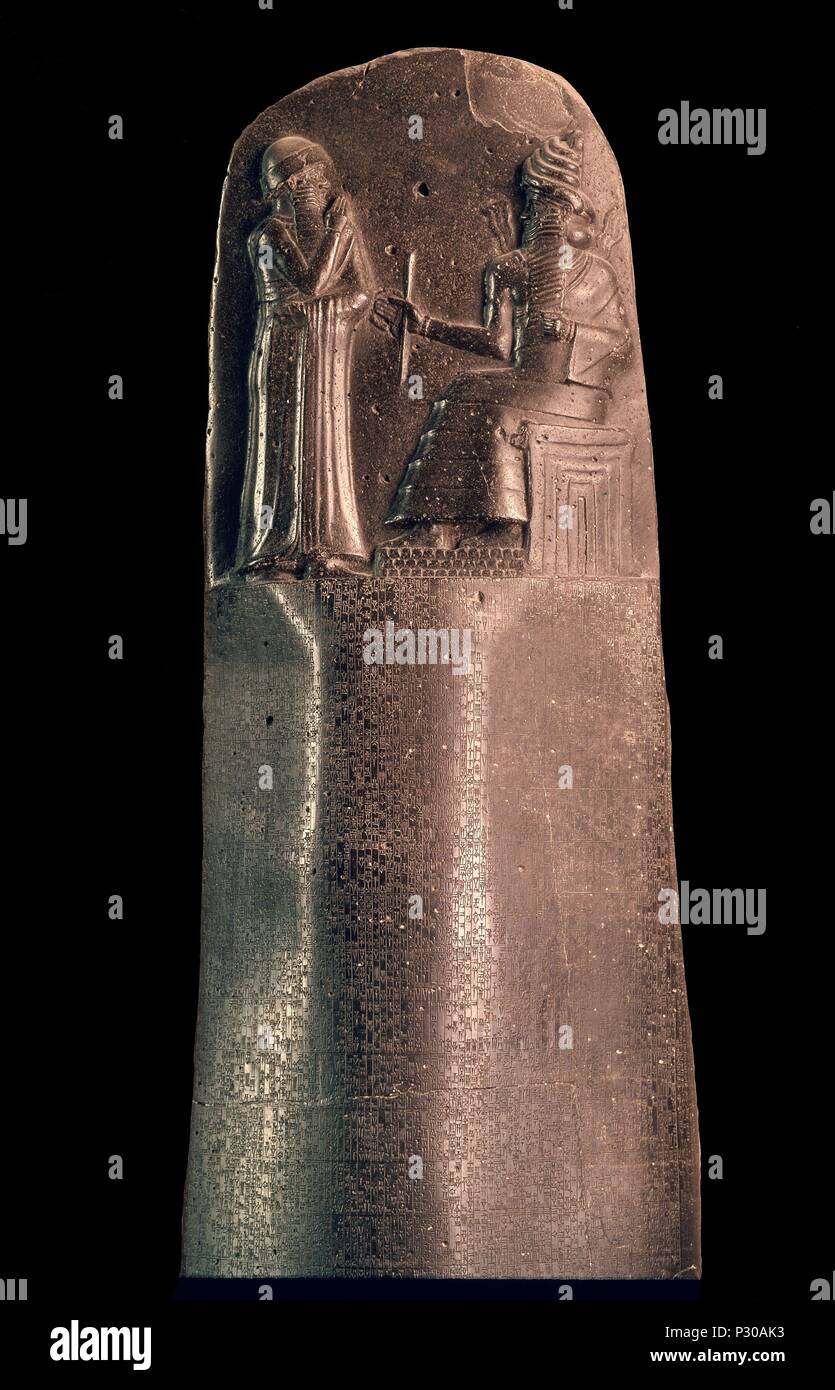 CODIGO DE HAMMURABI - PROCEDENTE DE SUSA - DIORITA - 1780 AC. Location: MUSEO DEL LOUVRE-ESCULTURAS, FRANCE. Stock Photohttps://www.alamy.com/image-license-details/?v=1https://www.alamy.com/codigo-de-hammurabi-procedente-de-susa-diorita-1780-ac-location-museo-del-louvre-esculturas-france-image208376759.html
CODIGO DE HAMMURABI - PROCEDENTE DE SUSA - DIORITA - 1780 AC. Location: MUSEO DEL LOUVRE-ESCULTURAS, FRANCE. Stock Photohttps://www.alamy.com/image-license-details/?v=1https://www.alamy.com/codigo-de-hammurabi-procedente-de-susa-diorita-1780-ac-location-museo-del-louvre-esculturas-france-image208376759.htmlRMP30AK3–CODIGO DE HAMMURABI - PROCEDENTE DE SUSA - DIORITA - 1780 AC. Location: MUSEO DEL LOUVRE-ESCULTURAS, FRANCE.
 Fragments of stela(e) inscribed with cuneiform script: extracts from the code of King Hammurabi of Babylon (1792-1750 BC). Around 1750BC. Basalt. Stock Photohttps://www.alamy.com/image-license-details/?v=1https://www.alamy.com/fragments-of-stelae-inscribed-with-cuneiform-script-extracts-from-the-code-of-king-hammurabi-of-babylon-1792-1750-bc-around-1750bc-basalt-image327387325.html
Fragments of stela(e) inscribed with cuneiform script: extracts from the code of King Hammurabi of Babylon (1792-1750 BC). Around 1750BC. Basalt. Stock Photohttps://www.alamy.com/image-license-details/?v=1https://www.alamy.com/fragments-of-stelae-inscribed-with-cuneiform-script-extracts-from-the-code-of-king-hammurabi-of-babylon-1792-1750-bc-around-1750bc-basalt-image327387325.htmlRF2A0HNTD–Fragments of stela(e) inscribed with cuneiform script: extracts from the code of King Hammurabi of Babylon (1792-1750 BC). Around 1750BC. Basalt.
 CODIGO DE HAMMURABI - PROCEDENTE DE SUSA - DIORITA - 1780 AC. Location: MUSEO DEL LOUVRE-ESCULTURAS, FRANCE. Stock Photohttps://www.alamy.com/image-license-details/?v=1https://www.alamy.com/codigo-de-hammurabi-procedente-de-susa-diorita-1780-ac-location-museo-del-louvre-esculturas-france-image208742547.html
CODIGO DE HAMMURABI - PROCEDENTE DE SUSA - DIORITA - 1780 AC. Location: MUSEO DEL LOUVRE-ESCULTURAS, FRANCE. Stock Photohttps://www.alamy.com/image-license-details/?v=1https://www.alamy.com/codigo-de-hammurabi-procedente-de-susa-diorita-1780-ac-location-museo-del-louvre-esculturas-france-image208742547.htmlRMP3H16Y–CODIGO DE HAMMURABI - PROCEDENTE DE SUSA - DIORITA - 1780 AC. Location: MUSEO DEL LOUVRE-ESCULTURAS, FRANCE.
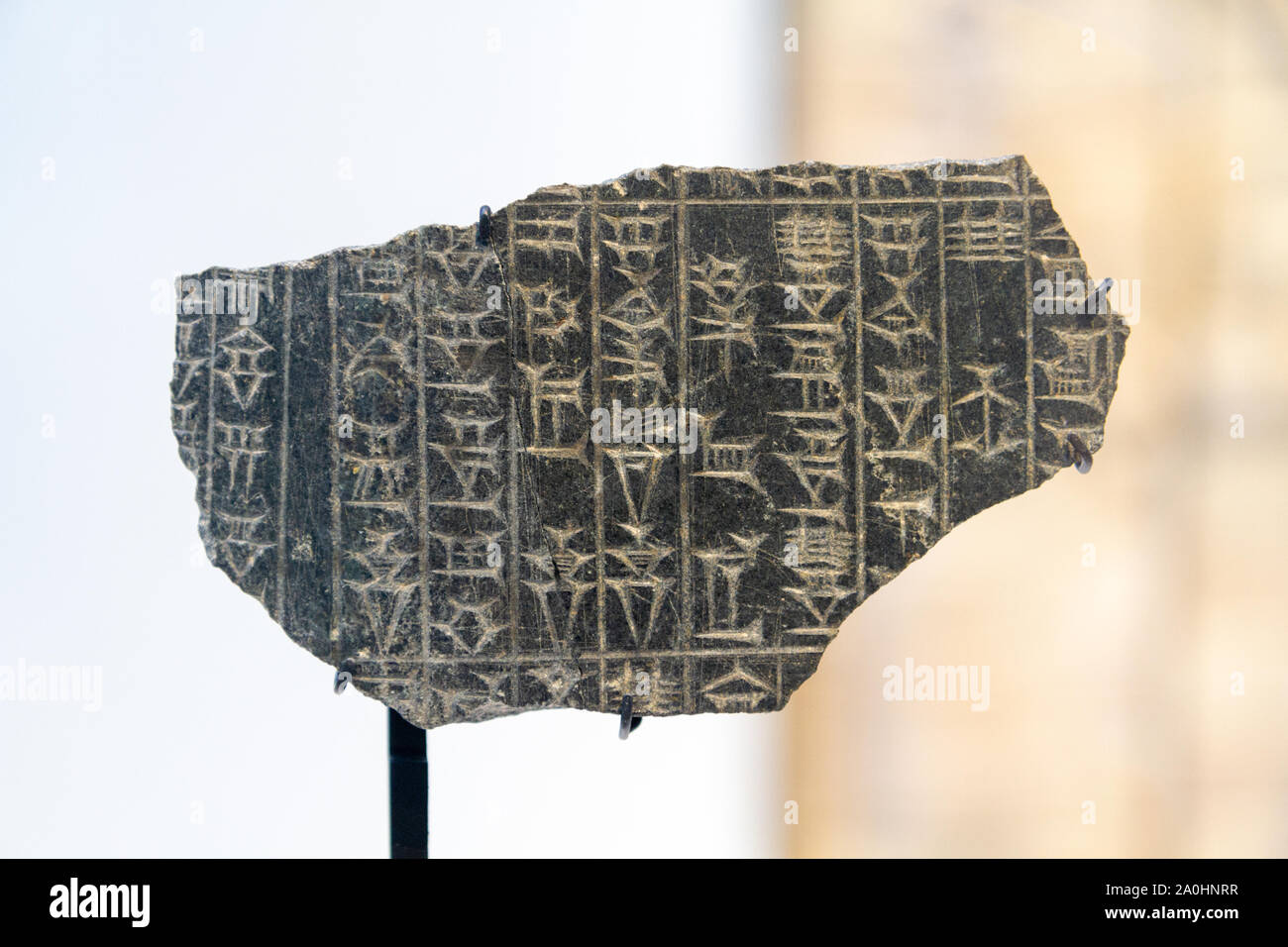 Fragments of stela(e) inscribed with cuneiform script: extracts from the code of King Hammurabi of Babylon (1792-1750 BC). Around 1750BC. Basalt. Stock Photohttps://www.alamy.com/image-license-details/?v=1https://www.alamy.com/fragments-of-stelae-inscribed-with-cuneiform-script-extracts-from-the-code-of-king-hammurabi-of-babylon-1792-1750-bc-around-1750bc-basalt-image327387307.html
Fragments of stela(e) inscribed with cuneiform script: extracts from the code of King Hammurabi of Babylon (1792-1750 BC). Around 1750BC. Basalt. Stock Photohttps://www.alamy.com/image-license-details/?v=1https://www.alamy.com/fragments-of-stelae-inscribed-with-cuneiform-script-extracts-from-the-code-of-king-hammurabi-of-babylon-1792-1750-bc-around-1750bc-basalt-image327387307.htmlRF2A0HNRR–Fragments of stela(e) inscribed with cuneiform script: extracts from the code of King Hammurabi of Babylon (1792-1750 BC). Around 1750BC. Basalt.
 Mesopotamia. Code of Hammurabi. Babylonian law code. 1754 BC. Akkadian language. Cuneiform script. Louvre Museum. Paris. France. Stock Photohttps://www.alamy.com/image-license-details/?v=1https://www.alamy.com/mesopotamia-code-of-hammurabi-babylonian-law-code-1754-bc-akkadian-language-cuneiform-script-louvre-museum-paris-france-image211294174.html
Mesopotamia. Code of Hammurabi. Babylonian law code. 1754 BC. Akkadian language. Cuneiform script. Louvre Museum. Paris. France. Stock Photohttps://www.alamy.com/image-license-details/?v=1https://www.alamy.com/mesopotamia-code-of-hammurabi-babylonian-law-code-1754-bc-akkadian-language-cuneiform-script-louvre-museum-paris-france-image211294174.htmlRMP7N7TE–Mesopotamia. Code of Hammurabi. Babylonian law code. 1754 BC. Akkadian language. Cuneiform script. Louvre Museum. Paris. France.
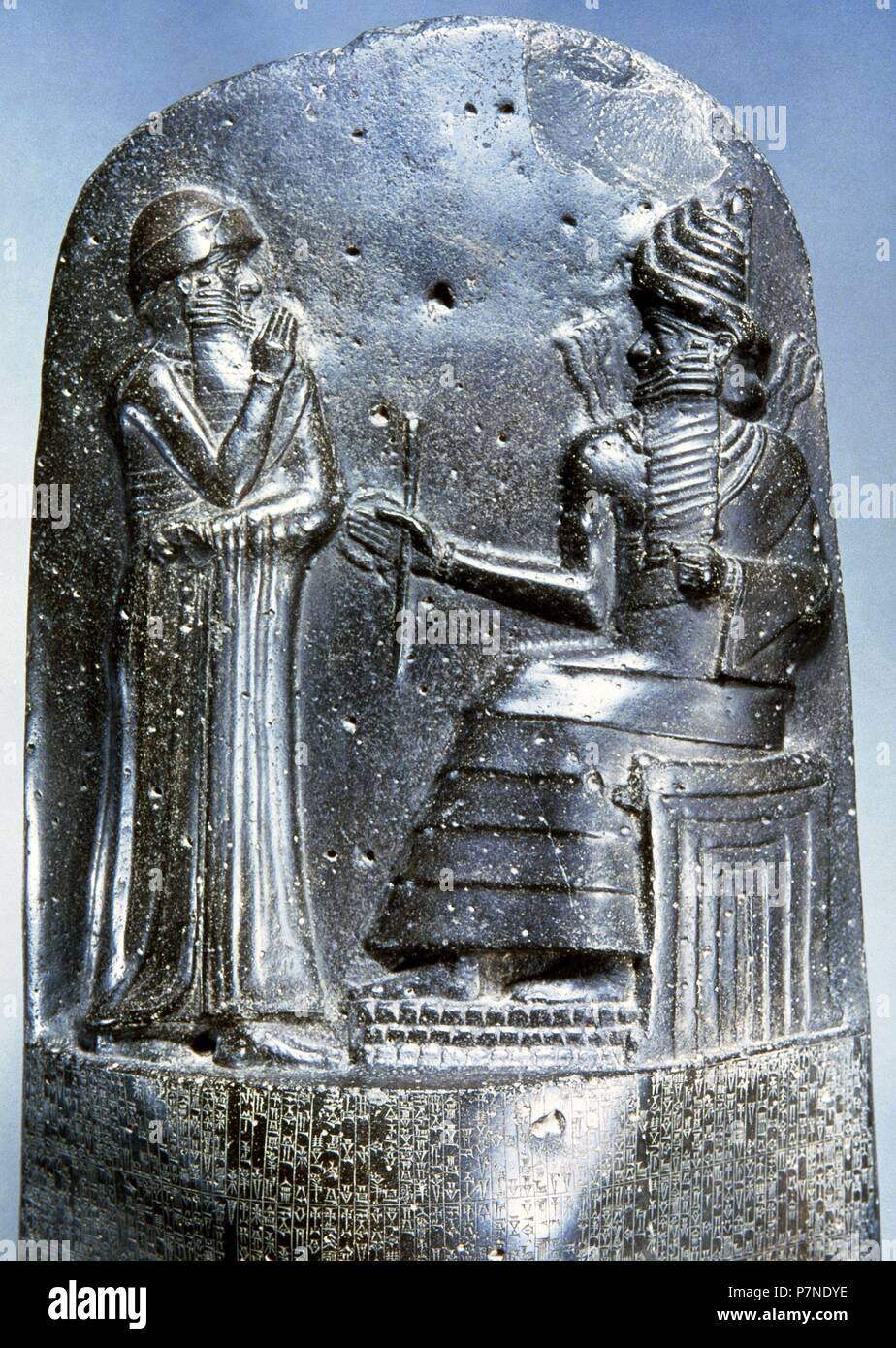 Law Code of Hammurabi, king of Babylon. Basalt. 18th century BC. Detail relief: Hammurabi (standing) depicted as receiving his royal insignia from Shamash, god of justice. Louvre Mueum. Paris, France. Stock Photohttps://www.alamy.com/image-license-details/?v=1https://www.alamy.com/law-code-of-hammurabi-king-of-babylon-basalt-18th-century-bc-detail-relief-hammurabi-standing-depicted-as-receiving-his-royal-insignia-from-shamash-god-of-justice-louvre-mueum-paris-france-image211298962.html
Law Code of Hammurabi, king of Babylon. Basalt. 18th century BC. Detail relief: Hammurabi (standing) depicted as receiving his royal insignia from Shamash, god of justice. Louvre Mueum. Paris, France. Stock Photohttps://www.alamy.com/image-license-details/?v=1https://www.alamy.com/law-code-of-hammurabi-king-of-babylon-basalt-18th-century-bc-detail-relief-hammurabi-standing-depicted-as-receiving-his-royal-insignia-from-shamash-god-of-justice-louvre-mueum-paris-france-image211298962.htmlRMP7NDYE–Law Code of Hammurabi, king of Babylon. Basalt. 18th century BC. Detail relief: Hammurabi (standing) depicted as receiving his royal insignia from Shamash, god of justice. Louvre Mueum. Paris, France.
 ARTE MESOPOTAMICO. ASIRIO-BABILONICO. S. XVIII a. C. CODIGO DE HAMMURABI. Monumento más importante de la antigua legislación mesopotámica. Primer código legislado para toda Mesopotamia. Detalle del REY (DINASTIA AMORITA, h. -1728 a h. -1686) ante la divinidad de SAMASH. Babilonia. Museo del Louvre. París. Francia. Stock Photohttps://www.alamy.com/image-license-details/?v=1https://www.alamy.com/arte-mesopotamico-asirio-babilonico-s-xviii-a-c-codigo-de-hammurabi-monumento-ms-importante-de-la-antigua-legislacin-mesopotmica-primer-cdigo-legislado-para-toda-mesopotamia-detalle-del-rey-dinastia-amorita-h-1728-a-h-1686-ante-la-divinidad-de-samash-babilonia-museo-del-louvre-pars-francia-image220382293.html
ARTE MESOPOTAMICO. ASIRIO-BABILONICO. S. XVIII a. C. CODIGO DE HAMMURABI. Monumento más importante de la antigua legislación mesopotámica. Primer código legislado para toda Mesopotamia. Detalle del REY (DINASTIA AMORITA, h. -1728 a h. -1686) ante la divinidad de SAMASH. Babilonia. Museo del Louvre. París. Francia. Stock Photohttps://www.alamy.com/image-license-details/?v=1https://www.alamy.com/arte-mesopotamico-asirio-babilonico-s-xviii-a-c-codigo-de-hammurabi-monumento-ms-importante-de-la-antigua-legislacin-mesopotmica-primer-cdigo-legislado-para-toda-mesopotamia-detalle-del-rey-dinastia-amorita-h-1728-a-h-1686-ante-la-divinidad-de-samash-babilonia-museo-del-louvre-pars-francia-image220382293.htmlRMPPF7T5–ARTE MESOPOTAMICO. ASIRIO-BABILONICO. S. XVIII a. C. CODIGO DE HAMMURABI. Monumento más importante de la antigua legislación mesopotámica. Primer código legislado para toda Mesopotamia. Detalle del REY (DINASTIA AMORITA, h. -1728 a h. -1686) ante la divinidad de SAMASH. Babilonia. Museo del Louvre. París. Francia.
 ARTE MESOPOTAMICO. ASIRIO-BABILONICO. S. XVIII a. C. CODIGO DE HAMMURABI. Monumento más importante de la antigua legislación mesopotámica. Primer código legislado para toda Mesopotamia. Detalle del REY (DINASTIA AMORITA, h. -1728 a h. -1686) ante la divinidad de SAMASH. Babilonia. Museo del Louvre. París. Francia. Stock Photohttps://www.alamy.com/image-license-details/?v=1https://www.alamy.com/arte-mesopotamico-asirio-babilonico-s-xviii-a-c-codigo-de-hammurabi-monumento-ms-importante-de-la-antigua-legislacin-mesopotmica-primer-cdigo-legislado-para-toda-mesopotamia-detalle-del-rey-dinastia-amorita-h-1728-a-h-1686-ante-la-divinidad-de-samash-babilonia-museo-del-louvre-pars-francia-image220381766.html
ARTE MESOPOTAMICO. ASIRIO-BABILONICO. S. XVIII a. C. CODIGO DE HAMMURABI. Monumento más importante de la antigua legislación mesopotámica. Primer código legislado para toda Mesopotamia. Detalle del REY (DINASTIA AMORITA, h. -1728 a h. -1686) ante la divinidad de SAMASH. Babilonia. Museo del Louvre. París. Francia. Stock Photohttps://www.alamy.com/image-license-details/?v=1https://www.alamy.com/arte-mesopotamico-asirio-babilonico-s-xviii-a-c-codigo-de-hammurabi-monumento-ms-importante-de-la-antigua-legislacin-mesopotmica-primer-cdigo-legislado-para-toda-mesopotamia-detalle-del-rey-dinastia-amorita-h-1728-a-h-1686-ante-la-divinidad-de-samash-babilonia-museo-del-louvre-pars-francia-image220381766.htmlRMPPF75A–ARTE MESOPOTAMICO. ASIRIO-BABILONICO. S. XVIII a. C. CODIGO DE HAMMURABI. Monumento más importante de la antigua legislación mesopotámica. Primer código legislado para toda Mesopotamia. Detalle del REY (DINASTIA AMORITA, h. -1728 a h. -1686) ante la divinidad de SAMASH. Babilonia. Museo del Louvre. París. Francia.
